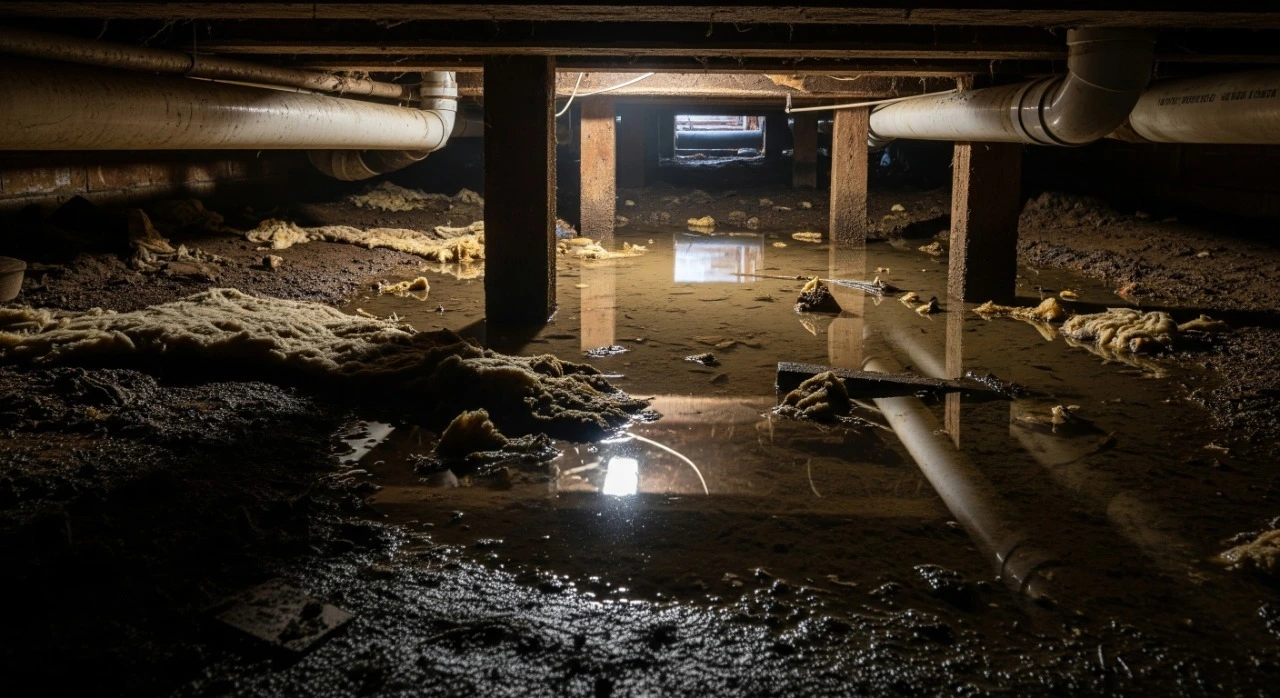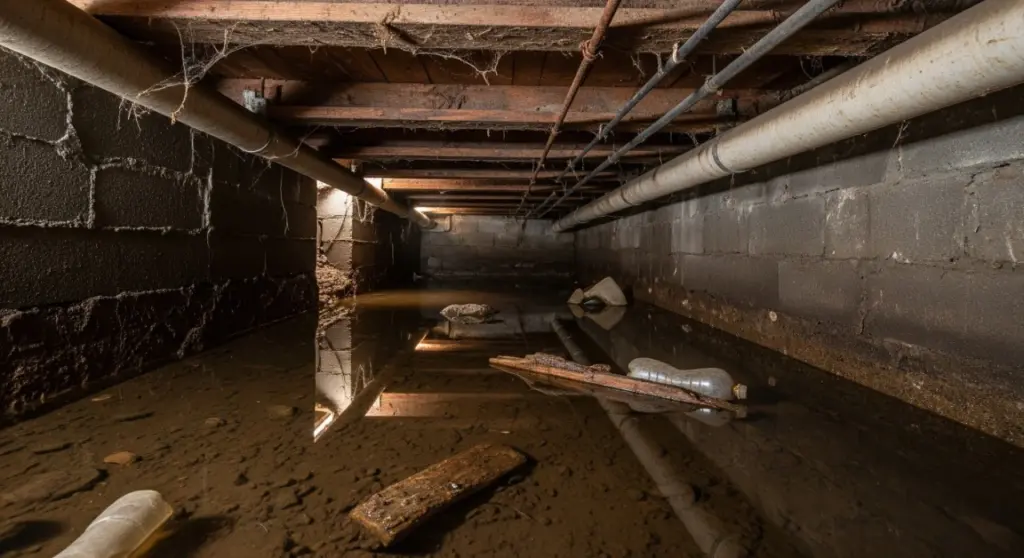
Introduction: That Stuffy Smell is a Big Red Flag
If you’ve detected a strong musty smell in your home that you just can’t trace, the culprit is probably concealed just beyond sight beneath your feet. The crawl space, out of sight and thus overlooked, is most likely the source of all your home’s ills, and that muddy, earthy aroma is its first telltale symptom.
A damp crawl space is not just a pest; it’s an actual health hazard to your house and your family’s health. The water is a reservoir which will rot wood, bug-out with insects, and force unhealthy indoor air into your entire house.
On the downside, a damp crawl space is not a permanent condition. This book will walk you from suspects to the dampness, the disastrous consequences of doing nothing at all, and the proven, professional treatments that can transform that soggy, unhealthy condition into a clean, dry, level space for your house.
Why Is My Crawl Space Wet? Finding the Cause
If you wish to fix a dampness problem correctly, you first must have some notion of where the water is actually coming from. Most crawl spaces are wet because of one or more of the following four issues:
- Groundwater Seepage: When storming and raining, water gets waterlogged in your ground surrounding your house. This puts immense “hydrostatic pressure” water loads on your foundation walls. Concrete is porous, and this pressure will force water into small cracks and capillaries, and your walls become damp or puddle on your floor.
- Bad Drainage & Runoff: Your home’s exterior drainage system is the first defense against water your home receives. You’ve clogged downspouts, or you’ve got water at your downspouts level with your home foundation, you’re directing thousands of gallons of water to your home foundation level. Therefore, if the ground (or “grade”) your house is on is sloping towards the foundation, water will flow there and into the crawl space.
- Leaky Pipes: The steady, constant drip of a water pipe or drain line leak in the crawl space can go unnoticed for months. This provides a constant source of water, which saturated the ground and insulation and keeps them saturated all the time.
- High Humidity & Condensation: Crawl space vents were required by building codes for decades based on the expectation that they would dry crawl spaces. We now realize in wet climates they do exactly the opposite. They allow warm, humid air into cold crawl spaces, and the moisture condenses on cooler surfaces such as pipes, ducts, and foundation walls—basically an indoor dew that clings to anything.
Long-term consequences of crawl space dampness are severe and will actually reach as far as your whole house.
Rotting Wood and Structural Damage: Subfloor wood, joists, and beams of your dwelling are extremely susceptible to water. Your crawl space is a wood rot and fungus mill when damp, and this will enable these structural elements to rot, which leads to sagging floors and costly repairs.
Mold, Mildew, and Your Family’s Health: A damp crawl space is a mildew and mold factory. The spores are pushed out into the air as airborne spores that drift up into your home’s living area through a natural ventilation system called the “stack effect.” In fact, 50% or more of the air in your first story originates in the crawl space. Exhalation of contaminated air in such ways may lead to allergies, asthma, and other respiratory problems. Pest Infestations: Pests are attracted by water. Termites and carpenter ants, cockroaches, mice and rats, and dust mites prefer damp, dark state of a water-damaged crawl space are attracted.
Higher Energy Bills: More money and energy are needed to cool and heat wet air compared to dry air. The soggy insulation also has reduced R-value and no functioning ability. Your HVAC works increasingly harder, which means sure higher bills each month.

The Path to a Dry Crawl Space: Proven Solutions
Draining a crawl space that is waterlogged is akin to telling you that you are going to have to fix water and moisture somewhere. You won’t be doing repairs; you have to have one system hold it all together.
Step 1: Seal the Exterior Source of Water
Next, always repair the issues easily visible out first. That means cleaning gutters, adding downspout extenders onto them to spread water at least 6 feet away from your foundation, and sloping around your house so that water drains away from walls.
Step 2: Tame Interior Water with Drainage
For controlling the groundwater that keeps seeping in, a pro-grade interior drain system is the guarantee. It is installing a perforated drainpipe into an inside-edge trench of your crawl space to suck in water. A sump pump relays the water, which keeps pushing it out of your house.
Step 3: Isolate with Encapsulation (Vapor Barrier)
This is most important step in the case of a permanent repair. Encapsulation of the crawl space is closing off the entire space from the damp ground. The heavy-duty, heavy-duty, and water-resistant liner (vapor barrier) is unrolled over the floor and up the walls. Sealed seams and sealed-off vents forever guarantee that any dampness in the ground will never reach your crawl space.
Step 4: Dehumidify the Air with a Dehumidifier
Step 4 is to control the humidity in the air after sealing off the space. A high-volume, high-efficiency crawl space dehumidifier is installed and set to operate automatically in an effort to maintain the relative humidity at or below 50%—the threshold for mold growth.
An issue of the whole house requires a solution of the whole house. By fighting the root of water and moisture with a professional-grade waterproofing and encapsulation system, you’re not putting a Band-Aid on it. You’re investing in your home’s value, your home’s integrity, and most importantly, your family’s health.
No longer will a wet, mildewed crawl space ravage your home. Allow a professional crawl space waterproofing company to intervene and initiate the path to a forever clean, dry, healthy foundation.
Frequently Asked Questions (FAQ)
Q: Why does my house smell damp?
A: That mildew or musty odor is generally due to mildew and mold growth in a unsealed, damp crawl space. Fungi gases produce the odor and these gases travel up to your living area.
Q: Can I simply lay down a plastic sheet from a hardware store myself?
A: It may be able to be fixed, but thin plastic sheeting is not appropriate and will not last. It’s not designed to be durable, won’t seal tightly, and won’t keep out all the moisture vapor. Professional encapsulation employs much thicker, puncture-resistant vapor barrier material that’s designed specifically to be used for that application.
Q: Do crawl space vents do more good than harm?
A: Crawlspace ventilation is generally a suboptimal feature of the house in most modern building science. In wet climates, there is higher water that enters the space than it vents out, and they encourage condensation and mold to grow. Sealing up the vents permanently as part of an integral encapsulation system is best.


